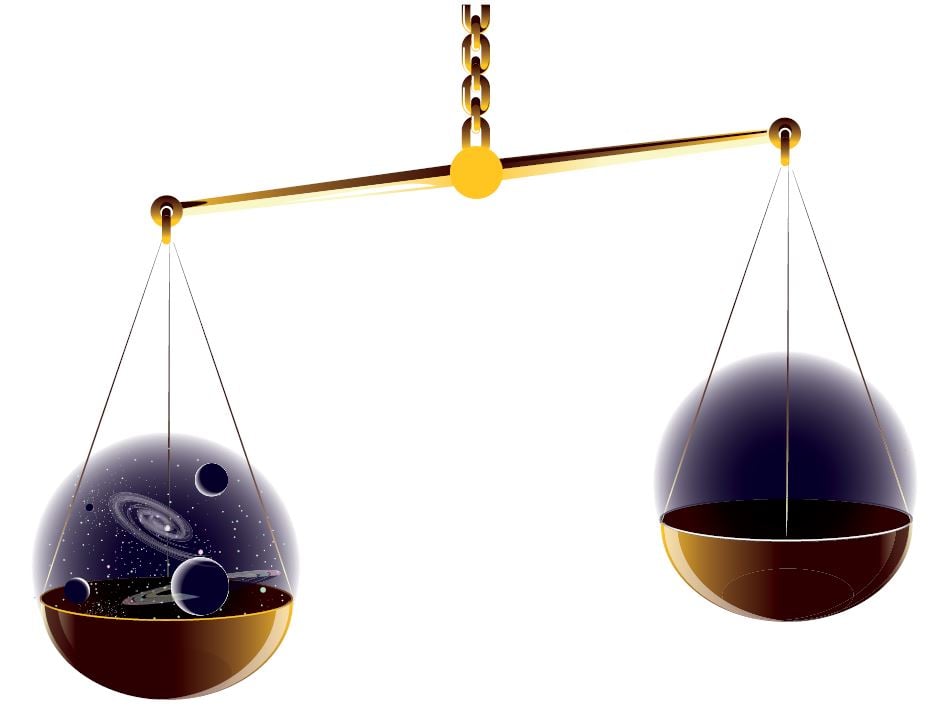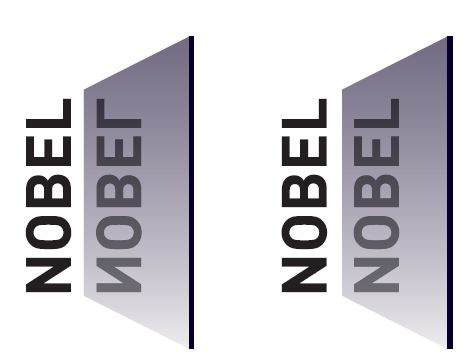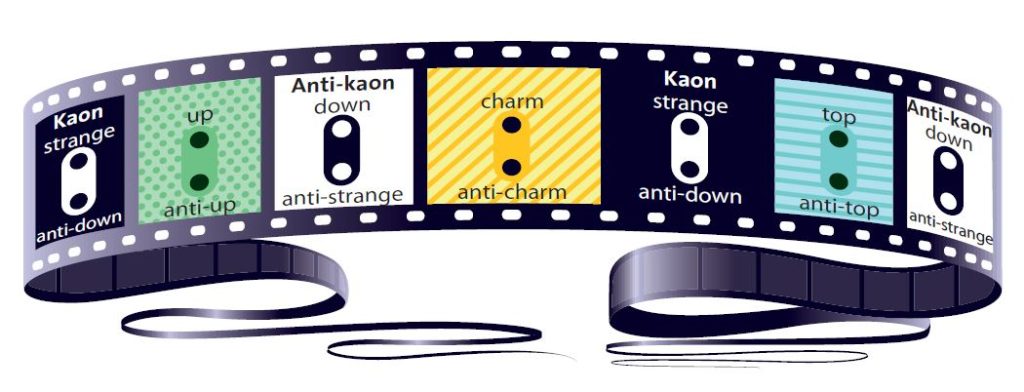Popular information
Information for the public:
Unravelling the hidden symmetries of nature (pdf)
Populärvetenskaplig information:
Symmetribrott i stort och smått (pdf)

The Nobel Prize in Physics 2008
Why is there something instead of nothing? Why are there so many different elementary particles? This year’s Nobel Laureates in Physics have presented theoretical insights that give us a deeper understanding of what happens far inside the tiniest building blocks of matter.
Unravelling the hidden symmetries of nature
Nature’s laws of symmetry are at the heart of this subject: or rather, broken symmetries, both those that seem to have existed in our universe from the very beginning and those that have spontaneously lost their original symmetry somewhere along the road.
In fact, we are all the children of broken symmetry. It must have occurred immediately after the Big Bang some 14 billion years ago when as much antimatter as matter was created. The meeting between the two is fatal for both; they annihilate each other and all that is left is radiation. Evidently, however, matter won against antimatter, otherwise we would not be here. But we are here, and just a tiny deviation from perfect symmetry seems to have been enough – one extra particle of matter for every ten billion particles of antimatter was enough to make our world survive. This excess of matter was the seed of our whole universe, which filled with galaxies, stars and planets – and eventually life. But what lies behind this symmetry violation in the cosmos is still a major mystery and an active field of research.

Through the looking glass
For many years physics has focused on finding the natural laws that are hidden deep within the wide range of phenomena we see around us. Natural laws should be perfectly symmetrical and absolute; they should be valid throughout the whole of the universe. This approach seems true for most situations, but not always. That is why broken symmetries became the subject of physics research as much as symmetries themselves, which is not so remarkable considering our lopsided world where perfect symmetry is a rare ideal.
Various types of symmetries and broken symmetries are part of our everyday life; the letter A does not change when we look at it in a mirror, while the letter Z breaks this symmetry. On the other hand, Z looks the same when you turn it upside down, but if you do the same with the letter A, the symmetry will be broken.

The basic theory for elementary particles describes three different principles of symmetry: mirror symmetry, charge symmetry and time symmetry (in the language of physics, mirror symmetry is called P, from parity, C stands for charge symmetry and T for time symmetry).
In mirror symmetry, all events should occur in exactly the same way whether they are seen directly or in a mirror. There should not be any difference between left and right and nobody should be able to decide whether they are in their own world or in a looking glass world. Charge symmetry states that particles should behave exactly like their alter egos, antiparticles, which have exactly the same properties but the opposite charge. And according to time symmetry, physical events at the micro level should be equally independent whether they occur forwards or backwards in time.
Symmetries do not just have an aesthetic value in physics. They simplify many awkward calculations and therefore play a decisive role for the mathematical description of the microworld. An even more important fact is that these symmetries implicate a large number of conservation laws at the particle level. For example, there is a law that energy cannot be lost in collisions between elementary particles, it must remain the same before and after the collision, which is evident in the symmetry of equations that describe particle collisions. Or there is the law of the conservation of electrical charges that is related to symmetry in electromagnetic theory.
The pattern emerges more clearly
It was around the middle of the 20th century that broken symmetry first appeared in studies of the basic principles of matter. At this time physics was thoroughly involved in achieving its greatest dream – to unite all nature’s smallest building blocks and all forces in one unified theory.
But to begin with, particle physics only became more and more complicated. New accelerators built after the Second World War produced a constant stream of particles that had never been seen before. Most of them did not fit into the models physicists had at that time, that matter consisted of atoms with neutrons and protons in the nucleus and electrons round it. Deeper investigations into the innermost regions of matter revealed that protons and neutrons each concealed a trio of quarks. The particles that had already been discovered also were shown to consist of quarks.


Now, almost all the pieces of the puzzle have fallen into place; a Standard Model for the indivisible parts of matter comprises three families of particles (see diagram). These families resemble each other, but only the particles in the first and lightest family are sufficiently stable to build up the cosmos. The particles in the two heavier families live under very unstable conditions and disintegrate immediately into lighter kinds of particles.
Everything is controlled by forces. The Standard Model, at least for the time being, includes three of nature’s four fundamental forces along with their messengers, particles that convey the interaction between the elementary particles (see diagram). The messenger of the electromagnetic force is the photon with zero mass; the weak force that accounts for radioactive disintegration and causes the sun and the stars to shine is carried by the heavy W and Z boson particles; while the strong force is carried by gluon particles, which see to it that the atom nuclei hold together. Gravity, the fourth force, which makes sure we keep our feet on the ground, has not yet been incorporated into the model and poses a colossal challenge for physicists today.
The mirror is shattered
The Standard Model is a synthesis of all the insights into the innermost parts of matter that physics has gathered during the last century. It stands firmly on a theoretical base consisting of the symmetry principles of quantum physics and the theory of relativity and has stood up to countless tests. But before the pattern was quite clear, a number of crises occurred that threatened this well-balanced construction. These crises related to the fact that physicists had assumed that the laws of symmetry applied to the Lilliputian world of elementary particles. But this, it turned out, was not entirely the case.
The first surprise came in 1956 when two Chinese-American theoreticians, Tsung Dao Lee and Chen Ning Yang (awarded the Nobel Prize the following year in 1957) challenged mirror symmetry (P symmetry) in the weak force. That nature respected mirror symmetry, the symmetry concerning left and right, was considered, like other symmetry principles, to be a well-established fact.
We need to re-evaluate old principles in the quantum world, where the elementary particles exist, claimed Lee and Yang. They proposed a series of experiments to test this mirror symmetry. And sure enough, only a few months later the decay of the atom nucleus in the radioactive element cobalt 60 revealed that it did not follow the principles of mirror symmetry. The symmetry was broken when the electrons that left the cobalt nucleus preferred one direction to another. It was as if you were standing in front of the Stockholm Central station and saw most of the people turning left out from the station.
Inherent asymmetry determines our fate
It may well be that charge and mirror symmetries are broken separately, but both of them, the so called CP-symmetry, are certainly not broken at the same time. The physicist community consoled itself with the idea that this symmetry remains unbroken. The laws of nature, they believed, would not change if you stepped into a mirror world where all matter was replaced with antimatter.
This also means that if you met an extraterrestrial being, there should not be any way of deciding whether the alien came from our world or from the antiworld. A welcoming hug could then have disastrous consequences. Only a puff of energy would be left when matter and antimatter annihilated each other on first contact.

So it was perhaps just as well that the weak force came back into the limelight in 1964. A new violation of the symmetry laws emerged in the radioactive decay of a strange particle, called a kaon (Nobel Prize awarded to James Cronin and Val Fitch in 1980). A small fraction of the kaons did not follow the current mirror and charge symmetries; they broke the double CP-symmetry and challenged the whole structure of the theory.
Thinking about meeting extraterrestrial beings, this discovery offers a salvation. It might be enough to ask an extraterrestrial before it hugs you to first look carefully at the kaon decay at home and check whether it is made of the same matter as us or antimatter.
The first person to point out the decisive importance of broken symmetry for the genesis of the cosmos was the Russian physicist and Nobel Peace Prize Laureate Andrei Sakharov. In 1967, he set up three conditions for creating a world like ours, empty of antimatter. Firstly, that the laws of physics distinguish between matter and antimatter, which in fact was discovered with the broken CP-symmetry ; secondly, that the cosmos originated in the heat of the Big Bang; and thirdly, that the protons in every atom nucleus disintegrate. The last condition might lead to the end of the world, since it implies that all matter can eventually disappear. But so far that has not happened; and experiments have shown that protons remain stable for 1033 years, a comfortable 10 trillion times longer than the age of the universe, which is slightly more than 1010 years. And still there is no one who knows how Sakharov’s chain of events took place in the early universe.
Solving the mystery of the broken symmetry
It may well be that Sakharov’s conditions will eventually be incorporated into the Standard Model of physics. Then the surplus of matter created at the birth of the universe will be explained. That, however, requires a much greater symmetry violation than the doubly broken symmetry, that Fitch and Cronin found in their experiment.
However, even a considerably smaller broken symmetry that the kaons were guilty of, needed an interpretation; otherwise the whole Standard Model would be threatened. The question of why the symmetries were broken remained a mystery until 1972, when two young researchers from the University of Kyoto, Makoto Kobayashi and Toshihide Maskawa, who were well acquainted with quantum physics calculations, found the solution in a 3 x 3 matrix.
How does this double broken symmetry take place? Each kaon particle consists of a combination of a quark and an antiquark. The weak force makes them switch identities time and time again: the quark becomes an antiquark while the antiquark becomes a quark, thus transforming the kaon into its antikaon. In this way the kaon particle flips between itself and its antiself. But if the right conditions are met, the symmetry between matter and antimatter will be broken. Kobayashi and Maskawa’s calculation matrix contains probabilities for describing how the transformation of the quarks will take place.

It turned out that the quarks and antiquarks swapped identity with each other within their own family. If this exchange of identity with double broken symmetry was to take place between matter and antimatter, a further quark family was needed in addition to the other two. This was a bold concept, and the Standard Model received these speculative new quarks, which appeared as predicted in later experiments. The charm quark was discovered as early as 1974, the bottom quark in 1977 and the last one, the top quark, as late as 1994.
Meson factories provide the answer
It may well be that the explanation of broken CP-symmetry also provides a raison d’être for the second and third particle families. These resemble the first family in many respects, but are so short-lived that they cannot form anything lasting in our world. One possibility is that these capricious particles fulfilled their most important function at the beginning of time when their presence guaranteed the broken symmetry that made matter win against antimatter. How nature solved this problem is, as mentioned before, something we do not yet know in detail. The broken symmetry needs to be reproduced many, many times to create all the matter that gives us our star-scattered sky.
Kobayashi and Maskawa’s theory also indicated that it should be possible to study a major violation of symmetry in B-meson particles, which are ten times heavier than their cousins, the kaons. However, broken symmetry occurs extremely rarely in B-mesons, so immense quantities of these particles are needed to find just a few that break the symmetry. Two gigantic constructions housing the BaBar particle detectors at the SLAC accelerator at Stanford, California and Belle at the KEK accelerator at Tsukuba in Japan produced more than one million B-mesons a day in order to follow their decay in detail. As early as 2001, both independent experiments confirmed the symmetry violation of the B-mesons, exactly as Kobayashi and Maskawa’s model had predicted almost 30 years earlier.
This meant the completion of the Standard Model, which has worked well for many years. Almost all the missing pieces of the puzzle have fallen into place in accordance with the boldest of predictions. All the same, the physicists are still not content.
Symmetry lies hidden under spontaneous violations
As already explained, the Standard Model comprises all of the known elementary particles and three of the four fundamental forces. But why are these forces so different? And why do the particles have such different masses? The heaviest one, the top quark, is more than three hundred thousand times heavier than the electron. Why do they have any mass at all? The weak force stands out in this respect again: its messenger particles, W and Z, are much heavier, while its ally, the photon, which conveys the electromagnetic force, lacks mass at all.
Most physicists believe that another spontaneous broken symmetry, called the Higgs mechanism, destroyed the original symmetry between forces and gave the particles their masses in the very earliest stages of the universe.
The road to this discovery was mapped out by Yoichiro Nambu when, in 1960, he was the first to introduce spontaneous symmetry violation into elementary particle physics. It is for this discovery that he is now awarded the Nobel Prize in Physics. To begin with, Nambu worked on theoretical calculations of another remarkable phenomenon in physics, superconductivity, when electric currents suddenly flow without any resistance. Spontaneous symmetry violation that described superconductivity was later translated by Nambu into the world of elementary particles, and his mathematical tools now permeate all theories concerning the Standard Model.
We can witness more banal spontaneous symmetry violations in everyday life. A pencil standing on its point leads a completely symmetrical existence in which all directions are equal. But this symmetry is lost when it falls over – now only one direction counts. On the other hand, its condition has become more stable, the pencil cannot fall any further, it has reached its lowest level of energy.

A vacuum has the lowest possible energy level in the cosmos. In fact, a vacuum in physics is precisely a state with the lowest possible energy. But it is not empty by any means. Since the arrival of quantum physics, a vacuum is defined as full of a bubbling soup of particles that pop up, only to immediately disappear again in ubiquitously present but invisible quantum fields. We are surrounded by many different quantum fields across space; the four fundamental forces of nature are also described as fields. One of them, the gravitational field, is known to us all. It is the one that keeps us down on earth and determines what is up and what is down.
Nambu realised at an early date that the properties of a vacuum are of interest for studies of spontaneous broken symmetry. A vacuum, that is, the lowest state of energy, does not correspond to the most symmetrical state. As with the fallen pencil, the symmetry of the quantum field has been broken and only one of many possible field directions has been chosen. In recent decades, Nambu’s methods of treating spontaneous symmetry violation in the Standard Model have been refined; they are frequently used today to calculate the effects of the strong force.
Higgs provides mass
The question of the mass of elementary particles has also been answered by spontaneous broken symmetry of the hypothetical Higgs field. It is thought that at the Big Bang the field was perfectly symmetrical and all the particles had zero mass. But the Higgs field, like the pencil standing on its point, was not stable, so when the universe cooled down, the field dropped to its lowest energy level, its own vacuum according to the quantum definition. Its symmetry disappeared and the Higgs field became a sort of syrup for elementary particles; they absorbed different amounts of the field and got different masses. Some, like the photons, were not attracted and remained without mass; but why the electrons acquired mass at all is quite a different question that no one has answered yet.
Like other quantum fields, the Higgs field has its own representative, the Higgs particle. Physicists are eager to find this particle soon in the world’s most powerful particle accelerator, the brand new LHC at Cern in Geneva. It is possible that several different Higgs particles will be detected – or none at all. Physicists are prepared, a so-called supersymmetric theory is the favourite among many to extend the Standard Model. Other theories exist, some more exotic, some less so. In any case, they are likely to be symmetrical, even though the symmetry may not be evident at first. But it is there, keeping itself hidden in the seemingly messy appearance.
Links and further reading
Popular scientific articles
Sarah Graham: “In Search of Antimatter”, Scientific American, August 2001.
Helen Quinn, Michael Witherell: “The Asymmetry between Matter and Antimatter”, Scientific American, October 1998.
Madhusree Mukerjee: “Profile: Yoichiro Nambu”, Scientific American, February 1995.
Original scientific articles
M. Kobayashi, T. Maskawa: “CP Violation in the Renormalizable Theory of Weak Interaction”. Progress of Theoretical Physics 49 (1973) p. 652-657.
Y. Nambu, G. Jona-Lasinio: “A Dynamical Model of Elementary Particles based on an Analogy with Superconductivity II”, Physics Review 124 (1961) p. 246.
Y. Nambu, G. Jona-Lasinio: “A Dynamical Model of Elementary Particles based on an Analogy with Superconductivity I”, Physics Review 122 (1961) p. 345.
Earlier Nobel Prizes within the field
The Nobel Prize in Physics 1999
The Nobel Prize in Physics 1980
The Nobel Prize in Physics 1969
The Nobel Prize in Physics 1957
The Laureates
YOICHIRO NAMBU
University of Chicago, Department of Physics, Enrico Fermi Institute
5720 South Ellis Avenue, Chicago, IL 60637 USA
http://physics.uchicago.edu/research/areas/ particle_t.html#Nambu
US citizen. Born 1921 in Tokyo, Japan. D.Sc. 1952 at University of Tokyo, Japan.
Harry Pratt Judson Distinguished Service Professor Emeritus at Enrico Fermi Institute, University of Chicago, IL, USA.
MAKOTO KOBAYASHI
Japan Society for the Promotion of Science (JSPS)
Ichibancho Office 1, Sumitomo-Ichibancho Bldg., 6 Ichibancho
Chiyoda-ku, Tokyo 102-8471, JAPAN
www.kek.jp/intra-e/press/2007/EPSprize2_e.html
Japanese citizen. Born 1944 in Nagoya, Japan. Ph.D. 1972 at Nagoya University, Japan.
Professor Emeritus at High Energy Accelerator Research Organization (KEK), Tsukuba, Japan.
TOSHIHIDE MASKAWA
Kyoto Sangyo University, Department of Physics
Motoyama, Kamigamo Kita-ku, Kyoto-City 603-8555, JAPAN
www.yukawa.kyoto-u.ac.jp/english
Japanese citizen. Born 1940. Ph.D. 1967 at Nagoya University, Japan.
Professor Emeritus at Yukawa Institute for Theoretical Physics (YITP), Kyoto University, and Professor at Kyoto Sangyo University, Japan.
© The Royal Swedish Academy of Sciences
Nobel Prizes and laureates
Six prizes were awarded for achievements that have conferred the greatest benefit to humankind. The 12 laureates' work and discoveries range from proteins' structures and machine learning to fighting for a world free of nuclear weapons.
See them all presented here.
